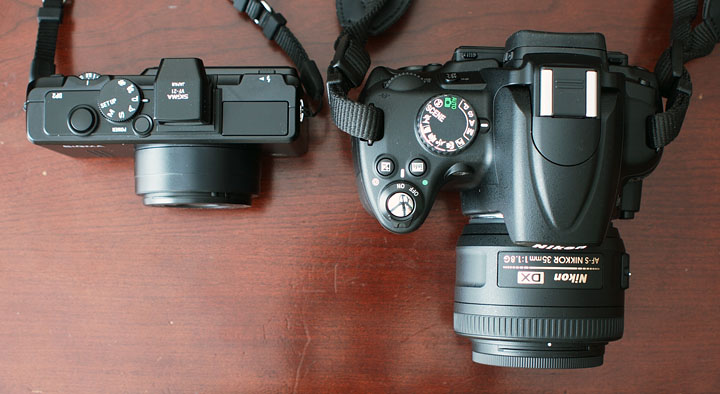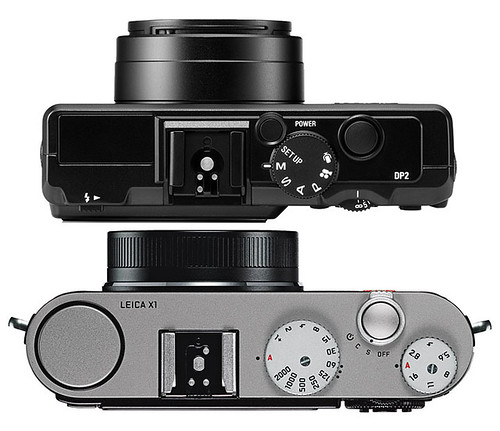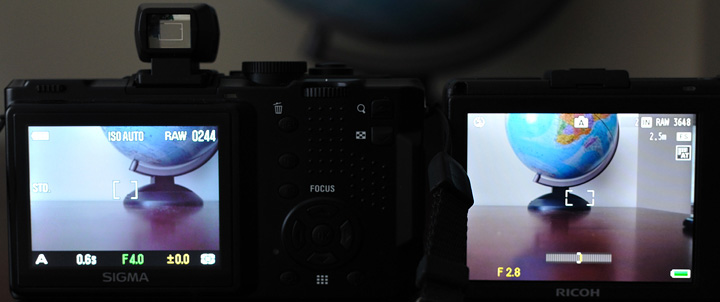Size
Sigma created the category of large-sensor compact camera and presently remain the only company with a fixed lens large-sensor camera on the market. Amongst all current large-sensor cameras, the DP2 is the second most compact, closely following the DP1.
In contrast to any Micro 4/3 camera-lens combo, a DP2 without hood or accessory optical viewfinder (OVF) will fit in a standard pants pocket. However, the DP2 is no shirt pocket camera.
Here's how the DP2 compares in size and shape with an advanced small sensor compact, the Ricoh GR Digital (GRD) III:


Compared to the Panasonic GH1 and M. Zuiko 17mm f/2.8:


Keep in mind that the DP2 sensor is intermediate in size between that of a Micro 4/3 camera and that of a 1.5x crop APS-C camera such as that of Samsung NX or Nikon APS-C.
Lets see how the DP2 compares in size to a small Nikon APS-C rig:


Build quality
The Sigma DP2 is extremely light when compared to any Micro Four Thirds combination and featherweight in comparison to any DSLR gear. This has led a number of observers to state that it feels "cheap". Likely the nondescript looks also contribute to this assessment. In contrast, I appreciate the lack of weight hanging around my neck and don't find anything wanting in the DP2 build quality. There is no give or creak in the DP2 body. Dials, controls, and battery door are all solid. Accessories such as the optional OVF and hood snap are likewise nicely fitted.
Look and sound
With regards to looks, Sigma has chosen a serious and discreet appearance. I'd prefer something with a bit more flair, but many will prefer the staid DP.
Like the DP1, the DP2 makes an unpleasant noise when extending the lens and is a bit noisier than I'd like when autofocusing. The shutter click is very quiet and unlikely to be noticed.
Controls and usability
The DP2 is boxy, but I find it very comfortable to grip and use for an extended period. Controls are well designed though not outstanding. Compare to the recently announced Leica X1 (images carefully resized to proper scale):

To give the DP2 its due, the primary apparent exposure parameters - aperture, shutter speed, and ISO - are all readily available during use of the camera, which is more than I can say for a number of serious compacts. In manual exposure mode, the rocker switch controls shutter speed which the left/right buttons (on the four way controller) determine aperture settings. In aperture priority mode, the rocker controls aperture, and left/right controls exposure compensation. The 'QS' button gives rapid access to ISO control. Simple and effective. One niggle is that auto ISO will select only from ISO 100-400. I would prefer to be able to choose the top ISO as is possible on the GH1 and D5000.
The LCD display, widely criticized with the DP1, remains below average for a camera of this class. It's not a show stopper for me, but a better LCD would be welcome. Here you can see the LCD of the DP1 (left) compared with that of the GRD III (right) with both at their default brightness:

Operational speed
Autofocus remains on the slow side, slower than that of the GH1 with M. Zuiko 17mm lens (which itself doesn't focus as quickly as the G1 kit zoom) and slower also than the GRD III. The DP2 focus also struggles more in low light than those other two cameras. That said, the DP2 focus is accurate and is quicker when one limits the focus range to farther distances by selecting the landscape focus mode. As with the DP1, a focus confirmation light is visible without removing one's eye from the OVF.
Manual focus is well implemented. I prefer the DP2 focus wheel to the manual focus implementation on the GH1 or GRD III because there is a visible, palpable control by which one can reliably scale focus at medium and small aperture settings.
Pressing the 'OK' button (with the latest firmware) gives a magnified view for manual focus. I'd prefer if Sigma would have the display automatically present a magnified view whenever the manual focus dial is turned, as is the case by default with the GH1. However the current DP2 implementation is very good.
The buffer has been improved from that of the DP1. One can now take photos in RAW with a shot-to-shot time of approximately 2.5 seconds, which is short enough for me although a two shot buffer without waiting would be even better.
In Part 2 of this shootout-based review, we'll take a look at lens performance.
Sigma DP2 Shootout Pt. 1 - Form and Function
Saturday, September 12, 2009
Sigma DP2 Shootout Pt. 1 - Form and Function
2009-09-12T14:06:00-05:00
Amin
Subscribe to:
Post Comments (Atom)
Recent Posts
-
▼
2009
(119)
-
▼
September
(19)
- GRD III Impressions / Review at Wouter Brandsma Ph...
- Face Detection
- Panasonic Lumix 20mm f/1.7 Review at DPReview
- Featured Photographer: Vern Dewit
- Sigma DP2 Shootout Supplement: Bokeh
- Sigma DP2 Shootout Pt. 3 - Dynamic Range
- New Site for Micro Four Thirds Reviews
- The End of an Era
- Sigma DP2 Shootout Pt. 2 - Detailed Scene
- Short Ricoh GR Digital 3 impression
- 2010 Micro Four Thirds Lens Roadmap: What's Missing?
- Sigma DP2 Shootout Pt. 1 - Form and Function
- Update on the Sigma DP2 - Olympus E-P1 Shootout
- E-P1 - GH1 Size Comparison
- Leica M9 ISO Test at Focus Numerique
- Leica X1: A Digital Hexar AF?
- Direct View Interchangeable Lens (DVIL): The Devil...
- Which Micro Four Thirds: A Personal Rationalization
- It's Official: Panasonic GF1
-
▼
September
(19)

